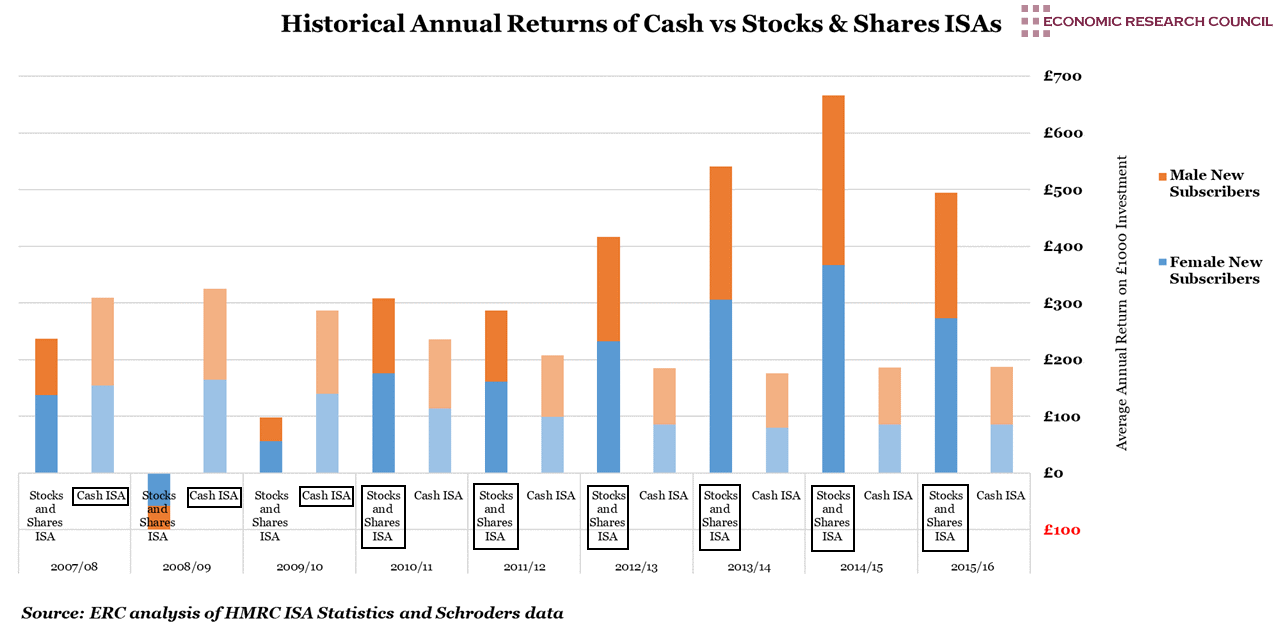
Summary
In general, women hold more ISAs than men (an average of 52% across ISA products), however in every year displayed, men are more likely to opt for stocks and shares ISAs when they do invest in ISAs. The number of men subscribing to new ISAs has fallen in recent years, reflecting an increased appetite for other, higher-risk investments. Although stocks and shares ISAs are more volatile, they have consistently delivered a higher return than cash ISAs since 2009. Returns from cash ISAs have fallen 41% between 2007 and 2016, but in contrast to stocks and shares ISAs, returns from cash ISAs have remained positive. At their most profitable, stocks and shares ISAs offered holders an average £666 return per £1000 investment. For cash ISAs, the figure is £325. Holders of stocks and shares ISAs in 2008 suffered losses of £100 on a £1000 investment due to the financial crash, although stocks and shares ISAs recovered to pre-crash levels within 3 years. Cash ISAs are yet to reach pre-crash levels with 2015/16 products offering just 61% of what customers received in 2007.
What does the chart show?
The chart shows the different ISA investing habits of male and females, denoted by the orange/blue split within each bar, representing the proportion of male and female new subscribers respectively. The bars display the average annual return on a £1000 investment of each product. The black boxes on the x axis highlight the product that gave the highest return in each year. The chart combines data from the annual HMRC Individual Savings Account (ISA) report and data from Schroders showing average Cash ISA and stocks and shares ISA returns. The data is from 2007 through 2015/16.
Why is the chart interesting?
An investor with funds in a cash ISA for the last 18 years would have received returns four times lower than stocks and shares ISAs, despite the dotcom and the 2007/8 recessions. Since 2008/9, when Cash ISAs gave a return of £325 per £1000 compared to a loss of £100 in stocks and shares ISAs; low interest rates and high inflation have eroded their returns. Despite this, Cash ISAs have consistently attracted higher number of subscribers, perhaps drawn to their relative stability. Only in the first 2 years following the products’ creation in 1999 that investors have put more money in stocks and shares ISAs than cash ISAs. With the current split of male and female ISA holders, it would appear that women’s money is not working as hard for them as men’s, who generally prefer to hold stocks and shares ISAs.
Overall, men are more likely to accept higher risk investments including in the stock market, investment trusts, foreign currencies and, indeed, cryptocurrencies. Fidelity International’s report “The Financial Power of Women” asserts that men spend more than twice the percentage of their disposable income than women investing in the stock market, 13% versus 6%.
Undoubtedly, the evidence shows that women have held more low-risk investments than men. Although a range of possible causes for this exist, Fidelity asserts that close to a third (29%) of 1000 women surveyed report that an increase in salary would encourage them to invest more. They have also stated that a reduction in both work hours (48%) and time spent on household chores (29%) would afford them more time to research and familiarise themselves with investment opportunities.
In April 2018, the government increased the limit on funds in ISAs from £15240 to £20,000, whether this leads to higher subscriptions, or a change in distribution, remains to be seen.

